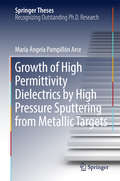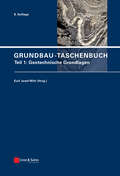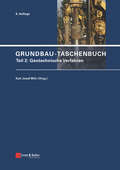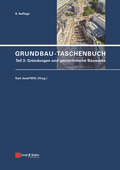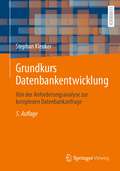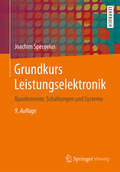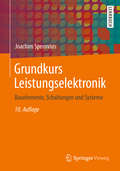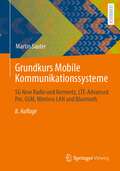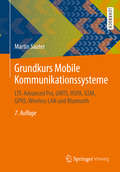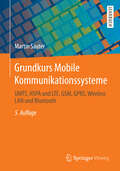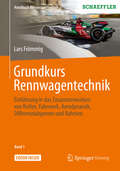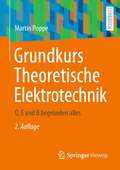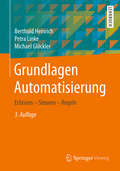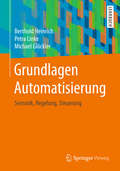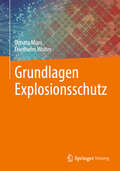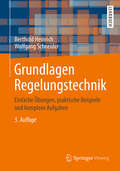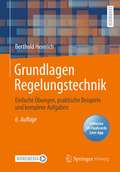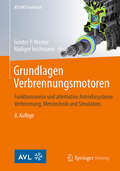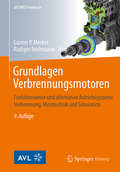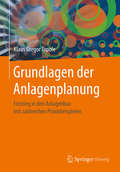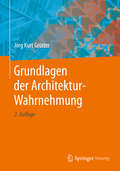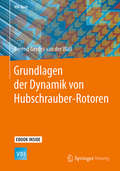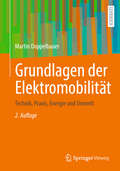- Table View
- List View
Growth of High Permittivity Dielectrics by High Pressure Sputtering from Metallic Targets
by María Ángela Pampillón ArceThis thesis describes the fabrication of metal-insulator-semiconductor (MIS) structures using very high permittivity dielectrics (based on rare earths) grown by high-pressure sputtering from metallic targets. It demonstrates the possibility of depositing high permittivity materials (GdScO3) by means of high pressure sputtering from metallic targets using in situ plasma oxidation on Si and indium phosphate (InP) substrates. The advantage of this system is the high working pressure, which causes the particles to undergo multiple collisions and become thermalized before reaching the substrate in a pure diffusion process, thus protecting the semiconductor surface from damage. This work presents a unique fabrication using metallic targets and involving a two-step deposition process: a thin metallic film is sputtered in an Ar atmosphere and this film is then plasma oxidized in situ. It also demonstrates the fabrication of GdScO3 on Si with a permittivity value above 30 from metallic Gd and Sc targets. Since co-sputtering was not possible, a nanolaminate of these materials was deposited and annealed. The electrical properties of these devices show that the material is highly interesting from a microelectronic integration standpoint.
Grundbau-Taschenbuch, Teil 1: Geotechnische Grundlagen (Grundbau-Taschenbuch)
by Karl Josef WittDas Grundbau-Taschenbuch hat seit über 60 Jahren zum Ziel, Entwicklungen, neue Erfahrungen und Erkenntnisse, Berechnungs- und Nachweismethoden für die Belange der Baupraxis umfassend zusammenzutragen und transparent zu vermitteln. Auch die 8. Auflage setzt das Format konsequent fort und bringt den aktuellen Stand der Wissenschaft und der Technik auf dem Gebiet des geotechnischen Ingenieurwesens in seinen wesentlichen Sparten zusammen. Der Teil 1 "Geotechnische Grundlagen" behandelt die Grundsätze der Sicherheitsnachweise, die Erkundung des Baugrundes, die physikalischen Eigenschaften von Boden und Fels, ihre Ermittlung und Bewertung, ihre Berücksichtigung in Stoffgesetzen und in konventionellen sowie numerischen Berechnungsmethoden, die Grundlagen der Bodendynamik, Phänomene der Massenbewegungen, den Umgang mit Schadstoffen im Boden und Grundwasser und die Methoden sowie Dokumentationsmöglichkeiten der Bauwerksbeobachtung. Die meisten Beiträge wurden grundlegend überarbeitet, einige von neuen Autoren oder Koautoren. Neu hinzugekommen ist das Kapitel "Statistik und Probabilistik in der geotechnischen Bemessung".
Grundbau-Taschenbuch, Teil 2: Geotechnische Verfahren (Grundbau-Taschenbuch)
by Karl Josef WittDas Grundbau-Taschenbuch ist das bekannteste und umfangreichste deutschsprachige Kompendium auf dem Gebiet der Geotechnik und hat seit über 60 Jahren zum Ziel, Entwicklungen, neue Erfahrungen und Erkenntnisse, aktuelle und neue Berechnungs- und Nachweismethoden für die Belange der Baupraxis umfassend zusammenzutragen und transparent zu vermitteln. Für die 8. Auflage wurde es umfassend überarbeitet und aktualisiert. Der zweite Teil des Grundbau-Taschenbuches behandelt die geotechnischen Verfahren mit ihren Berechnungs- und Nachweismethoden: Erdbau, Baugrundverbesserung, Injektions- und Ankertechnik, Bodenvereisung, Horizontalbohrungen und Rohrvortrieb, Rammen und Bohren, Grundwasserhaltung, geotechnisches Erdbebeningenieurwesen sowie Geokunststoffe im Erd- und Grundbau. Neu hinzugekommen ist ein Kapitel über hydraulisch bedingte Grenzzustände.
Grundbau-Taschenbuch, Teil 3: Gründungen und Geotechnische Bauwerke (Grundbau-Taschenbuch)
by Karl Josef WittDas Grundbau-Taschenbuch ist das bekannteste und umfangreichste deutschsprachige Kompendium auf dem Gebiet der Geotechnik und hat seit über 60 Jahren zum Ziel, Entwicklungen, neue Erfahrungen und Erkenntnisse, aktuelle und neue Berechnungs- und Nachweismethoden für die Belange der Baupraxis umfassend zusammenzutragen und transparent zu vermitteln. Für die 8. Auflage wurde es umfassend überarbeitet und aktualisiert.Der dritte Teil des Grundbau-Taschenbuches behandelt Gründungen und geotechnische Bauwerke. Die einzelnen Beiträge decken Flach- und Tiefgründungen mit ihren Sicherheitsnachweisen, Pfähle, Spundwände, Schlitzwände, Baugruben, Senkkästen sowie Stützbauwerke ab. Ebenso vertieft werden Spezialfragen wie Gründung von Bauwerken in Bergbaugebieten, im offenen Wasser und von Offshore-Windenergieanlagen.
Grundkurs Beschaffungsmanagement
by Holger BeckmannEine effektive und effiziente Beschaffung ist für Unternehmen ein wichtiger Erfolgsfaktor, insbesondere in Zeiten von geringer werdenden Fertigungs- und Entwicklungstiefen, kurzen Produktlebenszyklen, Zwang zu Kosteneffizienz, zur Nachhaltigkeit und zur Digitalisierung. Die sich stark wandelnden Anforderungen erfordern es, die Themen Prozessorientierung, Strategie und Management in der Beschaffung näher zu beleuchten. Das Lehrbuch kombiniert klassische Inhalte mit den heutigen Anforderungen. Wesentliche begriffliche und methodische Grundlagen und deren Zusammenhänge werden verdeutlicht und Entwicklungstrends in der Beschaffung aufzeigt. Dieses Buch bildet eine Grundlage, um Aufgaben in der Beschaffung aus einer prozessorientierten Sicht sowie methodische Ansätze zur Aufgabenbewältigung kennenzulernen.
Grundkurs Datenbankentwicklung: Von der Anforderungsanalyse zur komplexen Datenbankanfrage
by Stephan KleukerMit diesem Buch erhalten Studierende einen kompakten und praxisorientierten Einstieg, mit dem sie bereits früh im Studium sehr gut zurechtkommen. Die verschiedenen Phasen einer Datenbankentwicklung werden mit ihren Vorgehensweisen, Konzepten und möglichen Problemquellen vorgestellt. Gerade die Anforderungsanalyse und die Möglichkeit zur Erstellung mächtiger SQL-Anfragen werden als besonders praxisrelevante Aspekte betont. Durch die im zweiten Teil detailliert vorgestellte Integration von Datenbanken in die umgebende Software sind Studierende nach der Lektüre in der Lage, in Praxisprojekten erfolgreich mitzuarbeiten. Das Buch deckt inhaltlich eine Einführungsvorlesung vollständig ab. Die 5. Auflage wurde um das Thema JPA (Objekt-Relationale-Persistenz), Trigger in Java ergänzt. Zusätzlich werden Unterschiede zwischen Oracle, Maria DB, SQLite und Apache Derby erläutert. Neben vielen kleinen Beispielen zur Verdeutlichung einzelner Aspekte wird ein durchgehendes Beispiel genutzt. Alle Kapitel schließen mit Wiederholungsfragen und Übungsaufgaben, deren Lösungen online zum Download zur Verfügung stehen.
Grundkurs Leistungselektronik: Bauelemente, Schaltungen Und Systeme (Studium Technik Ser.)
by Joachim SpecoviusDieses Lehrbuch gibt eine verständliche Einführung in die Leistungselektronik. Aufbau und Wirkungsweise fremd-, last- und selbstgeführter Schaltungen werden vorgestellt. Steuerverfahren, Schalt- und Modulationsfunktionen werden behandelt. Komplexe Sachverhalte werden auf einfache Modelle reduziert. Funktionen werden mit einem geringen mathematischen Aufwand beschrieben. In der neunten Auflage wurde im Rahmen der Überarbeitung des Lehrbuches bei der elektromagnetischen Verträglichkeit in Kapitel 17 der Einfluss der parasitären Sperrschichtkapazität der Boost-Diode im Lückbetrieb betrachtet und in Kapitel 18 wurde zur Reduzierung der Schaltverluste durch ZVS die „phase-shift control strategy“ ergänzt. Unter springer.com stehen Zusatzmaterialien zum Buch bereit.
Grundkurs Leistungselektronik: Bauelemente, Schaltungen und Systeme (Studium Technik Ser.)
by Joachim SpecoviusDieses Lehrbuch gibt eine verständliche Einführung in die Leistungselektronik. Aufbau und Wirkungsweise fremd-, last- und selbstgeführter Schaltungen werden vorgestellt. Steuerverfahren, Schalt- und Modulationsfunktionen werden behandelt. Komplexe Sachverhalte werden auf einfache Modelle reduziert. Funktionen werden mit einem geringen mathematischen Aufwand beschrieben. In der zehnten Auflage wurde in Kapitel 9 die Beschreibung der HGÜ-Technik erweitert. In Kapitel 19 werden nun Energieversorgungsnetze einbezogen. Der Themenkomplex der elektrischen Fahrzeugantriebe bildet jetzt ein eigenes Kapitel.
Grundkurs Mobile Kommunikationssysteme: 5G New Radio und Kernnetz, LTE-Advanced Pro, GSM, Wireless LAN und Bluetooth
by Martin SauterDieses Buch bietet praxis- und detailgerechtes Wissen zu mobilen Kommunikationssystemen. Es führt klar und verständlich in die Technik und praktische Umsetzung von 5G New Radio und Kernnetz, LTE-Advanced Pro, GSM, GPRS, Wireless LAN und Bluetooth ein. Anhand vieler Beispiele wird fundiertes Wissen vermittelt und aufgezeigt, welche Möglichkeiten und Grenzen die unterschiedlichen Konzepte haben. Für die achte Auflage des Buches wurden alle Kapitel auf den neuesten Stand gebracht und enthalten zusätzlich ausführliche Ergänzungen zu aktuellen Entwicklungen. Dies umfasst z. B. LTE-Advanced Pro Themen wie Carrier Aggregation und Multi-Stream Übertragung (MIMO), neue Details zum Thema Wi-Fi wie z. B. Wi-Fi 6 (802.11ax), die neue WPA-3 Authentifizierung und Protected Management Frames. Wichtigste Ergänzung in dieser Auflage ist das neue Kapitel über 5G New Radio und das 5G Kernnetz.
Grundkurs Mobile Kommunikationssysteme: LTE-Advanced Pro, UMTS, HSPA, GSM, GPRS, Wireless LAN und Bluetooth
by Martin SauterDer Mobilfunk ist nach wie vor einer der sich am schnellsten entwickelnden Zweige der Telekommunikation und so erscheint nun schon die 7. Auflage des umfangreichen Nachschlagewerks. Detailliert und praxisnah aufbereitet liefert es grundlegendes Wissen zu den gängigen mobilen Kommunikationssystemen. Klar und verständlich erläutert der Autor die Technik der verschiedenen Standards für die mobile Datenübertragung, von GSM, GPRS, UMTS und HSPA bis zu LTE und LTE-Advanced Pro und Wirelesse LAN und Bluetooth. Jedes der fünf Kapitel gibt einen fundierten Überblick zum jeweiligen Mobilfunkstandard. Dabei zeigt der Autor an vielen Beispielen, wie die Technik im Detail funktioniert und welche Ideen hinter der Entwicklung der verschiedenen Systeme standen. Anhand von Vergleichen arbeitet er die verschiedenen Möglichkeiten und Grenzen der unterschiedlichen Datenübertragungstechnologien heraus und zeigt, dass sich häufig erst durch eine Kombination mehrerer Systeme eine interessante Anwendung ergibt. Jedes Kapitel schließt mit einem Fragen- und Aufgabenkatalog, mit dem Leser ihren Lernerfolg überprüfen können. Für die siebte Auflage des Buches hat der Autor erneut zahlreiche Überarbeitungen und Ergänzungen vorgenommen. Da heute in der Praxis der Hauptfokus auf dem LTE-System mit seinen schnellen Übertragungsraten liegt, beschreibt das Buch ausführlich neue Entwicklungen in dem Bereich wie LTE-Advanced Pro, Carrier Aggregation Narrowband-IoT und Voice over LTE (VoLTE). Daneben liefert die Neuauflage einen detaillierten Überblick über weitere Neuerungen, zum Beispiel Voice over Wifi (VoWifi) und die Eduroam Authentisierung. Das Buch richtet sich vornehmlich an Studierende der Fachrichtungen Informatik, Elektrotechnik und Nachrichtentechnik, empfiehlt sich aber auch als Praxishandbuch für Ingenieure in der Telekommunikationsbranche und sonstige IT-Experten.
Grundkurs Mobile Kommunikationssysteme: UMTS, HSPA und LTE, GSM, GPRS, Wireless LAN und Bluetooth
by Martin SauterDieses Buch bietet praxis- und detailgerechtes Wissen zu mobilen Kommunikationssystemen. Es führt klar und verständlich in die Technik und praktische Umsetzung von GSM, GPRS, UMTS, HSPA, LTE, Wireless LAN und Bluetooth ein. Anhand vieler Beispiele wird fundiertes Wissen vermittelt und aufgezeigt, welche Möglichkeiten und Grenzen die unterschiedlichen Konzepte haben. Durch viele Vergleiche wird deutlich, welche Kombination der Systeme für die jeweiligen Anwendungen am besten geeignet ist. Für die fünfte Auflage des Buches wurden alle Kapitel auf den neuesten Stand gebracht und enthalten zusätzlich ausführliche Ergänzungen zu aktuellen Entwicklungen. Dies umfasst z.B. die Weiterentwicklung der leitungsvermittelten Sprachtelefonie in GSM und UMTS Netzen, 3G High Speed Packet Access (HSPA+) Erweiterungen, Voice over LTE (VoLTE), sowie neue Details zu Wi-Fi Funktionen wie WPS und 802.11ac.
Grundkurs Rennwagentechnik: Einführung in das Zusammenwirken von Reifen, Fahrwerk, Aerodynamik, Differenzialsperren und Rahmen (Handbuch Rennwagentechnik #1)
by Lars FrömmigDer Schwerpunkt des Buchs liegt auf den fahrdynamischen Eigenschaften von Rennfahrzeugen. Es wird das rennfahrzeugspezifische Zusammenwirken des Reifens, der Aerodynamik des Fahrwerks und des Sperrdifferenzials behandelt. Ein Kapitel zu den Grundlagen der Fahrdynamik ermöglicht es auch ohne fahrzeugtechnische Vorbildung einen Einstieg in dieses Thema zu finden. Ein geschichtlicher Rückblick und eine Betrachtung der wesentlichen sicherheitstechnischen Aspekte schaffen ein Verständnis für übergeordnete Anforderungen, welche beispielsweise durch das technische Reglement vorgegeben werden.
Grundkurs Theoretische Elektrotechnik: Q, E und B begründen alles
by Martin PoppeDieses Buch erklärt, warum es verschiedene Varianten der Maxwell’schenGleichungen gibt und was genau die physikalische Bedeutung der in ihnenvorkommenden Größen ist. Gezeigt wird ferner, wie sich die Bestimmungsgleichungenfür statische elektrische und magnetische Potenziale aus denMaxwell’schen Gleichungen ergeben. Dabei ist die Rolle der dem Feld ausgesetzterMaterie immer von Anfang an integraler Bestandteil der Diskussion.Multipolentwicklungen werden begründet und hergeleitet. Fernerwird dargelegt, welches Vereinfachungspotenzial in der Formulierung derdynamischen Theorie als Eichfeldtheorie liegt. Die Gesetze der Optik werdenaus denen der Elektrodynamik hergeleitet. Für quasi-stationäre Rechnungenwerden Begründungen geliefert, Grenzen formuliert und technische Gegenbeispielegezeigt. Am Schluss wird auf weiterführende Literatur hingewiesen.Der Inhalt• Die klassische Elektrodynamik in der modernen Welt• Ladung und Strom• Die Maxwell’schen Gleichungen• Statische elektrische Felder• Statische Magnetfelder• Einige Eigenschaften zeitabhängiger Felder
Grundkurs Theoretische Elektrotechnik: Q, E und B begründen alles
by Martin PoppeDieses für die zweite Auflage gründlich überarbeitete Buch erklärt, warum es verschiedene Varianten der Maxwell’schen Gleichungen gibt und was genau die physikalische Bedeutung der in ihnen vorkommenden Größen ist. Gezeigt wird ferner, wie sich die Bestimmungsgleichungen für statische elektrische und magnetische Potenziale aus den Maxwell’schen Gleichungen ergeben. Dabei ist die Rolle der dem Feld ausgesetzter Materie immer von Anfang an integraler Bestandteil der Diskussion. Multipolentwicklungen werden begründet und hergeleitet. Ferner wird dargelegt, welches Vereinfachungspotenzial in der Formulierung der dynamischen Theorie als Eichfeldtheorie liegt. Die Gesetze der Optik werden aus denen der Elektrodynamik hergeleitet. Für quasi-stationäre Rechnungen werden Begründungen geliefert, Grenzen formuliert und technische Beispiele und Gegenbeispiele gezeigt. Am Schluss wird auf weiterführende Literatur hingewiesen.
Grundlagen Automatisierung: Erfassen - Steuern - Regeln
by Berthold Heinrich Michael Glöckler Petra LinkeDieses Lehrbuch gibt eine praxisnahe und anschauliche Einführung am Beispiel einer Schlüsselfertigung in die Fertigungsautomatisierung. Dieses Projekt verläuft durchgängig durch das Buch und integriert dann die Ergebnisse in Lösungen für diese Fertigungsanlage. Völlig neu in dieser Auflage sind Übungsaufgaben mit vollständigen Lösungen am Ende. Ein Glossar in Deutsch und Englisch mit Definitionen wichtiger Fachbegriffe unterstützt verlässlich die weiterführende Recherche.
Grundlagen Automatisierung: Sensorik, Regelung, Steuerung
by Berthold Heinrich Michael Glöckler Petra LinkeAufbauend auf den Grundlagen der Fertigungsautomatisierung wird eine praxisnahe Projektanlage konzipiert. Die Kapitel zur Sensorik, zur Steuerungs-, Regelungs- und Antriebstechnik integrieren dann die Ergebnisse in Lösungen für die Lernanlage. Ein Glossar der Fachbegriffe in Deutsch und Englisch unterstützt die weiterführende Recherche.
Grundlagen Explosionsschutz
by Friedhelm Wolter Donato MuroDieses kompakte Fachbuch vermittelt die grundlegenden Aspekte des Explosionsschutzes und dient als unerlässliche Ressource für Führungskräfte, Sicherheitsingenieure, Fachkräfte für Arbeitssicherheit, Techniker, Gewerkschaftsmitglieder und Arbeitnehmervertreter. Mit einer tiefgehenden Einführung in die wichtigsten Grundlagen des Explosionsschutzes ist dieses Buch ideal für alle, die in der Industrie und in sicherheitsrelevanten Berufen tätig sind. Es ermöglicht schnelle und fundierte Einblicke und dient als wertvolle Grundlage für die Erweiterung des Sicherheitswissens.
Grundlagen Regelungstechnik: Einfache Übungen, praktische Beispiele und komplexe Aufgaben
by Wolfgang Schneider Berthold HeinrichDieses Lehr- und Übungsbuch ist bewusst auf die Bedürfnisse des angehenden Ingenieurs ausgelegt, der mit durchgerechneten Beispielen und anlagenahen Anwendungen praxisgerecht in die Regelungstechnik eingeführt wird. Der mathematische Aufwand wird auf das für das Verständnis notwendige Maß reduziert. Einen Schwerpunkt bildet der Aufbau von Modellen aus physikalischen Grundgleichungen. Die Modelle werden mit Hilfe eines Simulationsprogramms getestet und für die Praxis parametrische Modelle entworfen. Zahlreiche Übungsaufgaben ermöglichen die Selbstkontrolle. Auf Grund kleinschrittiger Erklärungen ist es ideal geeignet für das Selbststudium als Bachelor-Student. Die aktuelle Auflage wurde vollständig überarbeitet und neu strukturiert.
Grundlagen Regelungstechnik: Einfache Übungen, praktische Beispiele und komplexe Aufgaben
by Berthold HeinrichDieses Lehr- und Übungsbuch ist bewusst auf die Bedürfnisse des angehenden Ingenieurs ausgelegt, der mit durchgerechneten Beispielen und anlagenahen Anwendungen praxisgerecht in die Regelungstechnik eingeführt wird. Der mathematische Aufwand wird auf das für das Verständnis notwendige Maß reduziert. Einen Schwerpunkt bildet der Aufbau von Modellen aus physikalischen Grundgleichungen. Die Modelle werden mit Hilfe eines Simulationsprogramms getestet und für die Praxis parametrische Modelle entworfen. Zahlreiche Übungsaufgaben ermöglichen die Selbstkontrolle. Auf Grund kleinschrittiger Erklärungen ist es ideal geeignet für das Selbststudium als Bachelor-Student. Die aktuelle Auflage wurde vollständig überarbeitet und neu strukturiert.
Grundlagen Verbrennungsmotoren: Funktionsweise und alternative Antriebssysteme Verbrennung, Messtechnik und Simulation (ATZ/MTZ-Fachbuch)
by Günter P. Merker Rüdiger TeichmannFür die vorliegende 8. Auflage wurde der Inhalt vollständig neu strukturiert und in kürzere und in sich abgeschlossene Kapitel aufgeteilt. Einleitend beschreibt das Werk die Funktionsweise von Verbrennungsmotoren für Fahrzeuge und stationäre Anwendungen sowie diejenige für alternative Antriebssysteme. Daran anschließend spannen die Autoren einen Bogen von einfachen thermodynamischen Grundlagen des Verbrennungsmotors hin zu komplexen Modellansätzen zur Beschreibung der Gemischbildung, Zündung, Verbrennung und Schadstoffbildung unter Beachtung der Motorperipherie von Otto- und Dieselmotoren. Damit liegt der inhaltliche Schwerpunkt dieses Bandes auf den Simulationsmodellen und deren strömungstechnischen, thermodynamischen und verbrennungschemischen Grundlagen sowie der Messtechnik zur Verifikation dieser Modelle, wie sie für die Entwicklung moderner Verbrennungsmotoren unentbehrlich sind. Für die aktuelle Auflage wurde vor allem das Thema alternative Antriebssysteme durch die Behandlung von Brennstoffzellen und elektrischen Antriebssystemen stark erweitert. Alle Kapitel wurden vollständig überarbeitet und aktualisiert.
Grundlagen Verbrennungsmotoren: Funktionsweise und alternative Antriebssysteme Verbrennung, Messtechnik und Simulation (ATZ/MTZ-Fachbuch)
by Günter P. Merker Rüdiger TeichmannFür die vorliegende 9. Auflage wurde der Inhalt vollständig neu strukturiert und in kürzere und in sich abgeschlossene Kapitel aufgeteilt. Einleitend beschreibt das Werk die Funktionsweise von Verbrennungsmotoren für Fahrzeuge und stationäre Anwendungen sowie diejenige für alternative Antriebssysteme. Daran anschließend spannen die Autoren einen Bogen von einfachen thermodynamischen Grundlagen des Verbrennungsmotors hin zu komplexen Modellansätzen zur Beschreibung der Gemischbildung, Zündung, Verbrennung und Schadstoffbildung unter Beachtung der Motorperipherie von Otto- und Dieselmotoren. Damit liegt der inhaltliche Schwerpunkt dieses Bandes auf den Simulationsmodellen und deren strömungstechnischen, thermodynamischen und verbrennungschemischen Grundlagen sowie der Messtechnik zur Verifikation dieser Modelle, wie sie für die Entwicklung moderner Verbrennungsmotoren unentbehrlich sind. Für die aktuelle Auflage wurde vor allem das Thema alternative Antriebssysteme durch die Behandlung von Brennstoffzellen und elektrischen Antriebssystemen stark erweitert. Alle Kapitel wurden vollständig überarbeitet und aktualisiert.
Grundlagen der Anlagenplanung: Einstieg in den Anlagenbau mit zahlreichen Praxisbeispielen
by Klaus Gregor TopoleDieses Buch bildet den Grundstein für die Anlagenplanung und die Begleitung internationaler Großprojekte. Es richtet sich an Menschen in Management und Projektleitung sowie an Studenten und Berufseinsteiger, die im internationalen Anlagenbau und Projektingenieurwesen arbeiten bzw. arbeiten werden. Die Herausforderungen im internationalen Großanlagenbau sind komplex. Gleichzeitig steigen internationale Ansprüche an Sicherheit, Umweltverträglichkeit, Qualität und Kosten. Am auffälligsten ist diese Entwicklung im Bau chemischer Großanlagen. Beginnend mit der Konzeptionierung, der Planung und dem Bau bis zur Inbetriebnahme werden die Zusammenhänge anhand vieler Praxisbeispiele verständlich und transparent dargestellt. Das Buch bildet eine verbindende Klammer um alle Ingenieursdisziplinen, die im internationalen Großanlagenbau ihren Beitrag leisten. Als neues Werk berücksichtigt es aktuelle Ergebnisse, Methoden, Vorgehensweisen und Vorschriften.
Grundlagen der Architektur-Wahrnehmung
by Jörg Kurt GrütterWarum wird über das Aussehen unserer gebauten Umwelt, über die Ästhetik der Architektur heute so viel gestritten? Warum divergieren die Meinungen über die ästhetische Qualität von Bauten oft auch bei Fachleuten extrem? Warum sind wir uns gerade bei der Architektur nicht einig, was schön ist und was nicht? Die meisten Bereiche des Bauens, wie zum Beispiel Statik und Bauphysik, sind messbar und deshalb auch mit objektiven Argumenten belegbar. Dies gilt nicht für die Ästhetik der Architektur; sie ist nicht quantifizierbar. Ein Urteil über sie ist immer subjektbezogen, stark vom Betrachter abhängig.Trotzdem ist die Ästhetik der Architektur nicht nur eine Frage des Geschmacks. Viele Zusammenhänge zwischen Gebäude als Objekt und Betrachter als Subjekt sind mit Hilfe von Wahrnehmungspsychologie und Informationstheorie objektiv bestimmbar.Das vorliegende Buch macht den äusserst komplexen Prozess der Architektur-Wahrnehmung auf eine einfache Art transparenter und trägt damit zu einem besseren Verständnis unserer gebauten Umwelt bei.
Grundlagen der Dynamik von Hubschrauber-Rotoren (VDI-Buch)
by Berend Gerdes van der WallBeginnend mit Unfällen frühester Hubschrauberentwürfe wird die Problematik der Rotordynamik erkennbar. Den Grundlagen eines allgemeinen Masse-Feder-Dämpfer-Systems folgt die Behandlung der isolierten Schlag-Schwenk- und Torsionsbewegung. Die mathematischen Methoden der Behandlung von Problemen der Rotordynamik werden erläutert. Die für dynamische Probleme notwendigen Grundlagen instationärer Aerodynamik und mit ihnen die verschiedenen dynamischen Probleme der gekoppelten Bewegungsformen werden analysiert sowie die Möglichkeiten der Einflussnahme erörtert. Als Besonderheit wird ausgiebig auf die verschiedenen Möglichkeiten aktiver Rotorsteuerung eingegangen und ihre Möglichkeiten, Vibrationen, Lärm und Antriebsleistung vorteilhaft zu beeinflussen. Die Anforderungen an Modelle im Windkanalversuch werden dargestellt.
Grundlagen der Elektromobilität: Technik, Praxis, Energie und Umwelt
by Martin DoppelbauerAusgehend von den Mobilitätsbedürfnissen der modernen Industriegesellschaft und den politischen Rahmenbedingungen zum Klimaschutz werden die unterschiedlichen Antriebs- und Ladekonzepte von batterieelektrischen- und hybridelektrischen Fahrzeugen vorgestellt und bewertet.
